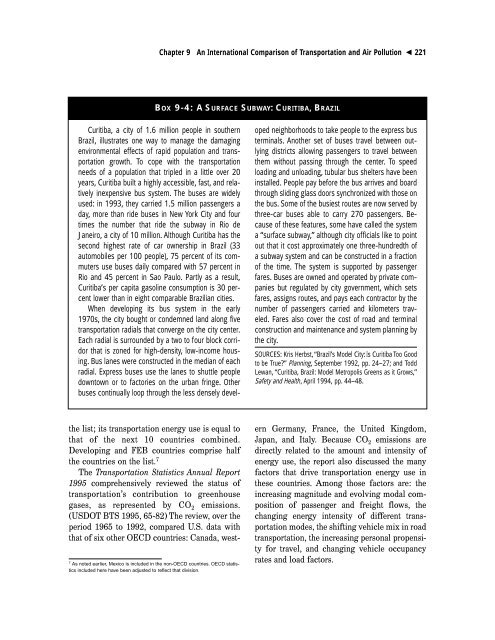table of contents - Research and Innovative Technology ...
table of contents - Research and Innovative Technology ...
table of contents - Research and Innovative Technology ...
Create successful ePaper yourself
Turn your PDF publications into a flip-book with our unique Google optimized e-Paper software.
the list; its transportation energy use is equal to<br />
that <strong>of</strong> the next 10 countries combined.<br />
Developing <strong>and</strong> FEB countries comprise half<br />
the countries on the list. 7<br />
The Transportation Statistics Annual Report<br />
1995 comprehensively reviewed the status <strong>of</strong><br />
transportation’s contribution to greenhouse<br />
gases, as represented by CO 2 emissions.<br />
(USDOT BTS 1995, 65-82) The review, over the<br />
period 1965 to 1992, compared U.S. data with<br />
that <strong>of</strong> six other OECD countries: Canada, west-<br />
Chapter 9 An International Comparison <strong>of</strong> Transportation <strong>and</strong> Air Pollution � 221<br />
Curitiba, a city <strong>of</strong> 1.6 million people in southern<br />
Brazil, illustrates one way to manage the damaging<br />
environmental effects <strong>of</strong> rapid population <strong>and</strong> transportation<br />
growth. To cope with the transportation<br />
needs <strong>of</strong> a population that tripled in a little over 20<br />
years, Curitiba built a highly accessible, fast, <strong>and</strong> relatively<br />
inexpensive bus system. The buses are widely<br />
used: in 1993, they carried 1.5 million passengers a<br />
day, more than ride buses in New York City <strong>and</strong> four<br />
times the number that ride the subway in Rio de<br />
Janeiro, a city <strong>of</strong> 10 million. Although Curitiba has the<br />
second highest rate <strong>of</strong> car ownership in Brazil (33<br />
automobiles per 100 people), 75 percent <strong>of</strong> its commuters<br />
use buses daily compared with 57 percent in<br />
Rio <strong>and</strong> 45 percent in Sao Paulo. Partly as a result,<br />
Curitiba’s per capita gasoline consumption is 30 percent<br />
lower than in eight comparable Brazilian cities.<br />
When developing its bus system in the early<br />
1970s, the city bought or condemned l<strong>and</strong> along five<br />
transportation radials that converge on the city center.<br />
Each radial is surrounded by a two to four block corridor<br />
that is zoned for high-density, low-income housing.<br />
Bus lanes were constructed in the median <strong>of</strong> each<br />
radial. Express buses use the lanes to shuttle people<br />
downtown or to factories on the urban fringe. Other<br />
buses continually loop through the less densely devel-<br />
7 As noted earlier, Mexico is included in the non-OECD countries. OECD statistics<br />
included here have been adjusted to reflect that division.<br />
BOX 9-4: A SURFACE SUBWAY: CURITIBA, BRAZIL<br />
oped neighborhoods to take people to the express bus<br />
terminals. Another set <strong>of</strong> buses travel between outlying<br />
districts allowing passengers to travel between<br />
them without passing through the center. To speed<br />
loading <strong>and</strong> unloading, tubular bus shelters have been<br />
installed. People pay before the bus arrives <strong>and</strong> board<br />
through sliding glass doors synchronized with those on<br />
the bus. Some <strong>of</strong> the busiest routes are now served by<br />
three-car buses able to carry 270 passengers. Because<br />
<strong>of</strong> these features, some have called the system<br />
a “surface subway,” although city <strong>of</strong>ficials like to point<br />
out that it cost approximately one three-hundredth <strong>of</strong><br />
a subway system <strong>and</strong> can be constructed in a fraction<br />
<strong>of</strong> the time. The system is supported by passenger<br />
fares. Buses are owned <strong>and</strong> operated by private companies<br />
but regulated by city government, which sets<br />
fares, assigns routes, <strong>and</strong> pays each contractor by the<br />
number <strong>of</strong> passengers carried <strong>and</strong> kilometers traveled.<br />
Fares also cover the cost <strong>of</strong> road <strong>and</strong> terminal<br />
construction <strong>and</strong> maintenance <strong>and</strong> system planning by<br />
the city.<br />
SOURCES: Kris Herbst,“Brazil’s Model City: Is Curitiba Too Good<br />
to be True?” Planning, September 1992, pp. 24–27; <strong>and</strong> Todd<br />
Lewan, “Curitiba, Brazil: Model Metropolis Greens as it Grows,”<br />
Safety <strong>and</strong> Health, April 1994, pp. 44–48.<br />
ern Germany, France, the United Kingdom,<br />
Japan, <strong>and</strong> Italy. Because CO 2 emissions are<br />
directly related to the amount <strong>and</strong> intensity <strong>of</strong><br />
energy use, the report also discussed the many<br />
factors that drive transportation energy use in<br />
these countries. Among those factors are: the<br />
increasing magnitude <strong>and</strong> evolving modal composition<br />
<strong>of</strong> passenger <strong>and</strong> freight flows, the<br />
changing energy intensity <strong>of</strong> different transportation<br />
modes, the shifting vehicle mix in road<br />
transportation, the increasing personal propensity<br />
for travel, <strong>and</strong> changing vehicle occupancy<br />
rates <strong>and</strong> load factors.

















